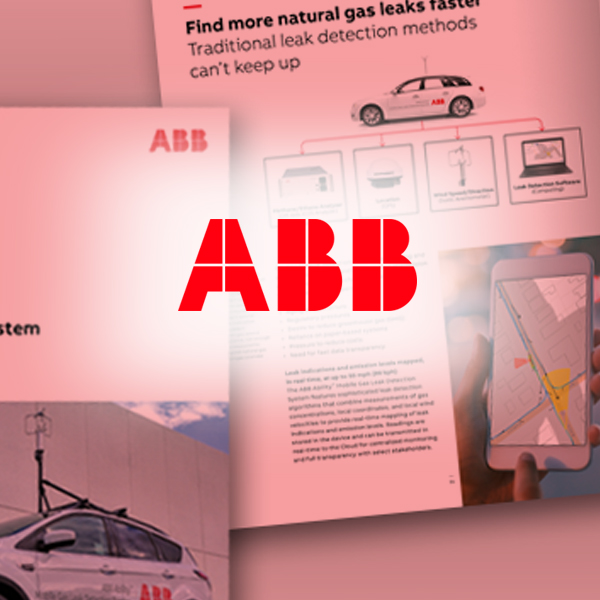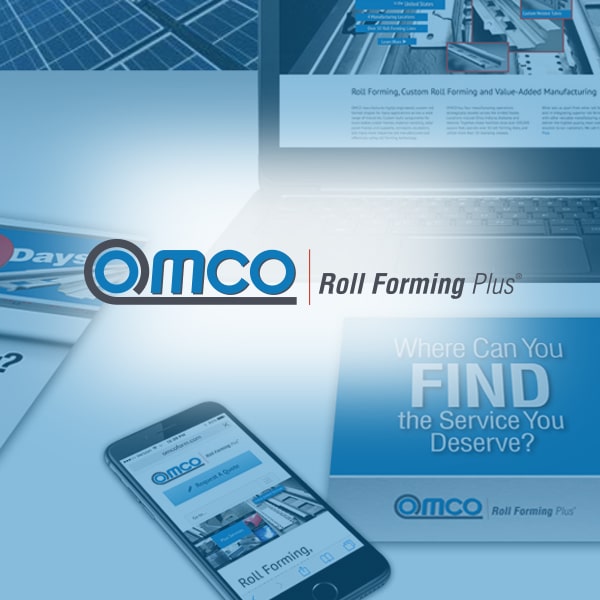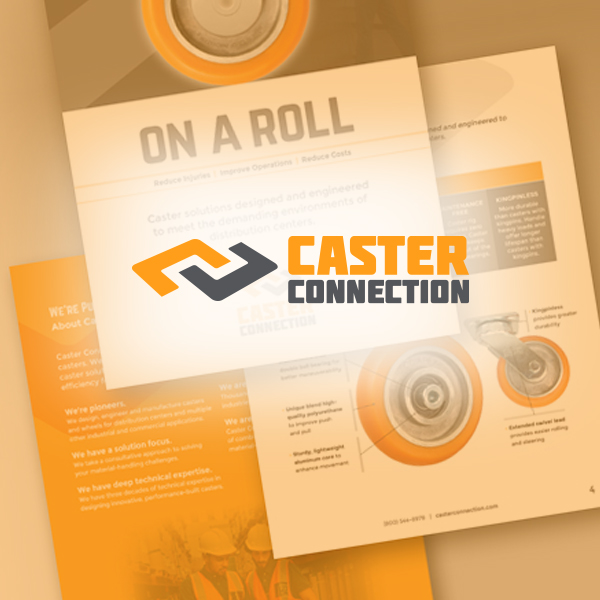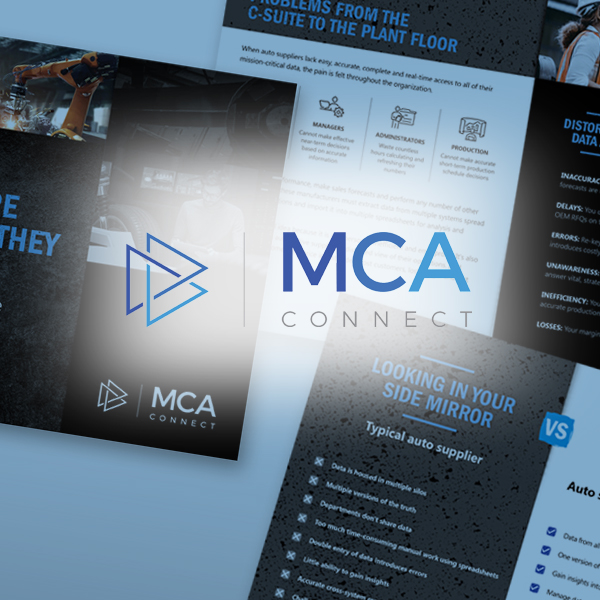Manufacturing Marketing Strategy Best Practices for Marketing to Numerous Markets

Written by Dan Konstantinovsky
Strategic Marketing, RH Blake
![]()
Manufacturing and industrial marketers are under constant pressure to drive more opportunities, leads and revenue while optimizing their marketing budget. And this pressure is only amplified when you also have to consider concurrently penetrating numerous, distinct markets.
There is an art and science to developing an effective target market strategy. RH Blake has developed a framework to help manufacturing marketers allocate their resources in a diverse and competitive marketplace.
Step 1: Understanding your market opportunity
Targeting potential customers who show the highest propensity to purchase begins by developing a narrative or persona of your ideal target customer. How many unique customer personas exist for the business units you market? What are their pain points? How do these customers find you? What channels do these potential customers interact with? Answers to questions like these will become the qualification criteria you use to gauge whether a prospect or customer segment is the best fit for your company’s product or service.
Once you qualify your ideal target customer you need to estimate the market size. We find that the TAM (Total Available Market) SAM (Serviceable Available Market) SOM (Serviceable Obtainable Market) model is useful in assessing market size. This work is often used to quantify the addressable and serviceable market, and your ability to win a share of the competitive landscape.
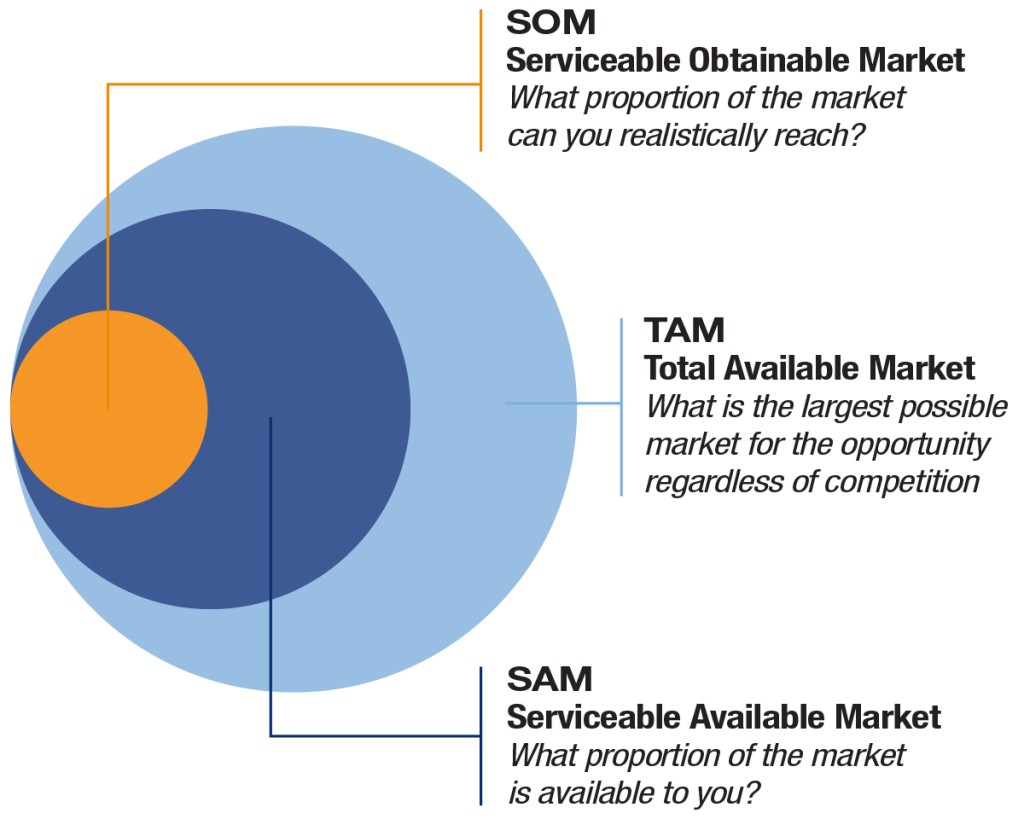
TAM – total available market / total addressable market is the first component, defined as the total market demand for a product and/or services. More specifically, this is all potential customers who could purchase your product/service, regardless of competitive forces, production and logistical limitations, geographical distance, etc. The TAM is the most abstract of the three components because it is dependent on your ability to align your company’s product or service offering with the needs of the customer and/or end user.
Drilling down further is the SAM, or serviceable available market or served available market. This is the portion of the TAM within your reach that you can target with your products and/or services. If you manufacture aftermarket automotive parts that fit 2018-2021 Jeep Wrangler vehicles, then the SAM for this example is that specific year/make segment of the total available Jeep market. The goal for marketing and sales is to identify and deploy tactics to serve and grow the proportion of the SAM within the TAM.
The SAM is important because it shows the potential of the business idea or market opportunity in the medium term. The more precisely you define the SAM, the more efficient and effective your marketing and sales team efforts will be.
The last component is the serviceable obtainable market, or SOM. This is the portion of the SAM that you will realistically attract with your products and/or services in the near term. Who will your sales team win with given considerations such as market size, offering and company capabilities, and level of competition?
TAM SAM SOM analysis is especially useful for marketers who are accountable for developing programs across numerous markets as it uses data to drive well informed marketing decisions. For many manufacturing marketers, understanding “who is a good fit?” is just as important as realizing who isn’t, as it helps avoid mismanaging engineering and sales resources.
Step 2: Setting the manufacturing sales team up for success
Collaboration and alignment across sales and marketing will frequently lead to more considerable and more strategic outcomes. A recent statistic cited by Aberdeen Strategy and Research found that 74% of “high-performing” companies have a strong sales and marketing alignment within their organization. This is one key reason many manufacturing organizations are realizing the strategic necessity of a formalized sales enablement approach. This is an iterative process where marketing provides the resources the sales team needs to improve their win rate. These resources might include developing and sharing a formal launch strategy, internal sales training material, video content, online product guides, tools like product configurators or calculators, and timely delivery of competitive intelligence. The enablement function element of the framework fosters a collaborative culture of seamless information sharing between marketing-sales.
As virtual environments become the norm, it is important to have highly engaged sales team members that feel connected. This can be done formally through mentorship programs, sales advisory councils, or tip-sharing among peers. The main objective is to remove any obstacles to information gathering and information sharing, maintain engagement, and encourage consistency.
Step 3: Understanding the competition
Competition forces marketers to be innovative and agile. Most marketing programs have access to similar marketing tools; success often comes down to effectively leveraging customer insights into marketing program execution.
Take an inventory of your competitive marketplace for each segment of your business. Create a narrative around what each competitor does well and what you feel they aren’t doing well. The narrative should include detail about each vertical market, brand, product line or new product, whatever the situation dictates.
Here are questions marketers should ask when considering their positioning in the competitive landscape:
- What customer problem are we trying to solve?
- What do I know about this market already?
- Is there a creative angle we can use to tell our story?
- What unique or underserved target audiences are there, and what is our ability to differentiate our offering with messaging within each segment?
- How effective will our existing sales force be at winning in this competitive landscape?
- Do our messages and the branding clearly line up? Is there any situation where the company is/isn’t linked to the messaging?
- How could this strategy lead to other opportunities/new markets/new targets we can win in the competitive marketplace?
Once you have put context to questions like these you can take inventory of the following when considering the direction of your marketing content.
Step 4: Developing a meaningful manufacturing content strategy
Once you’ve prioritized your target markets and gained a deeper understanding of the landscape, creating a content strategy that is aligned is critical. To help, consider the following questions:
- Does your content answer the most common questions you receive from customers or prospects?
- Are you able to develop content on a planned interval several weeks or months in advance?
- Are you identifying and actively managing the search keywords your ideal customers are using to find your product or service?
- What keywords present the best opportunity for your company to rank at the highest level?
- Are you leveraging relevant manufacturing or industrial resource directories?
- Are you featured on vendors’ websites as a valued partner?
- Are you leveraging tools like email and/or social media to promote video content, useful information, or product examples directing potential prospects to your website?
- Do you have effective conversion points throughout your website, offering a download or more information that is helpful for your visitor?
- Do you have case studies or testimonials that highlight your customers’ successes?
- Are you leveraging video, and are you doing consistently updating your video content library?
Conclusion
Manufacturing marketers faced with penetrating and growing multiple markets concurrently need to be especially effective at allocating and prioritizing marketing resources. The framework and considerations mentioned above will help ensure the decisions you make will drive desired marketing results.
Manufacturing Marketing Strategy Best Practices for Marketing to Numerous Markets

Written by Dan Konstantinovsky
Strategic Marketing, RH Blake
![]()
Manufacturing and industrial marketers are under constant pressure to drive more opportunities, leads and revenue while optimizing their marketing budget. And this pressure is only amplified when you also have to consider concurrently penetrating numerous, distinct markets.
There is an art and science to developing an effective target market strategy. RH Blake has developed a framework to help manufacturing marketers allocate their resources in a diverse and competitive marketplace.
Step 1: Understanding your market opportunity
Targeting potential customers who show the highest propensity to purchase begins by developing a narrative or persona of your ideal target customer. How many unique customer personas exist for the business units you market? What are their pain points? How do these customers find you? What channels do these potential customers interact with? Answers to questions like these will become the qualification criteria you use to gauge whether a prospect or customer segment is the best fit for your company’s product or service.
Once you qualify your ideal target customer you need to estimate the market size. We find that the TAM (Total Available Market) SAM (Serviceable Available Market) SOM (Serviceable Obtainable Market) model is useful in assessing market size. This work is often used to quantify the addressable and serviceable market, and your ability to win a share of the competitive landscape.

TAM – total available market / total addressable market is the first component, defined as the total market demand for a product and/or services. More specifically, this is all potential customers who could purchase your product/service, regardless of competitive forces, production and logistical limitations, geographical distance, etc. The TAM is the most abstract of the three components because it is dependent on your ability to align your company’s product or service offering with the needs of the customer and/or end user.
Drilling down further is the SAM, or serviceable available market or served available market. This is the portion of the TAM within your reach that you can target with your products and/or services. If you manufacture aftermarket automotive parts that fit 2018-2021 Jeep Wrangler vehicles, then the SAM for this example is that specific year/make segment of the total available Jeep market. The goal for marketing and sales is to identify and deploy tactics to serve and grow the proportion of the SAM within the TAM.
The SAM is important because it shows the potential of the business idea or market opportunity in the medium term. The more precisely you define the SAM, the more efficient and effective your marketing and sales team efforts will be.
The last component is the serviceable obtainable market, or SOM. This is the portion of the SAM that you will realistically attract with your products and/or services in the near term. Who will your sales team win with given considerations such as market size, offering and company capabilities, and level of competition?
TAM SAM SOM analysis is especially useful for marketers who are accountable for developing programs across numerous markets as it uses data to drive well informed marketing decisions. For many manufacturing marketers, understanding “who is a good fit?” is just as important as realizing who isn’t, as it helps avoid mismanaging engineering and sales resources.
Step 2: Setting the manufacturing sales team up for success
Collaboration and alignment across sales and marketing will frequently lead to more considerable and more strategic outcomes. A recent statistic cited by Aberdeen Strategy and Research found that 74% of “high-performing” companies have a strong sales and marketing alignment within their organization. This is one key reason many manufacturing organizations are realizing the strategic necessity of a formalized sales enablement approach. This is an iterative process where marketing provides the resources the sales team needs to improve their win rate. These resources might include developing and sharing a formal launch strategy, internal sales training material, video content, online product guides, tools like product configurators or calculators, and timely delivery of competitive intelligence. The enablement function element of the framework fosters a collaborative culture of seamless information sharing between marketing-sales.
As virtual environments become the norm, it is important to have highly engaged sales team members that feel connected. This can be done formally through mentorship programs, sales advisory councils, or tip-sharing among peers. The main objective is to remove any obstacles to information gathering and information sharing, maintain engagement, and encourage consistency.
Step 3: Understanding the competition
Competition forces marketers to be innovative and agile. Most marketing programs have access to similar marketing tools; success often comes down to effectively leveraging customer insights into marketing program execution.
Take an inventory of your competitive marketplace for each segment of your business. Create a narrative around what each competitor does well and what you feel they aren’t doing well. The narrative should include detail about each vertical market, brand, product line or new product, whatever the situation dictates.
Here are questions marketers should ask when considering their positioning in the competitive landscape:
- What customer problem are we trying to solve?
- What do I know about this market already?
- Is there a creative angle we can use to tell our story?
- What unique or underserved target audiences are there, and what is our ability to differentiate our offering with messaging within each segment?
- How effective will our existing sales force be at winning in this competitive landscape?
- Do our messages and the branding clearly line up? Is there any situation where the company is/isn’t linked to the messaging?
- How could this strategy lead to other opportunities/new markets/new targets we can win in the competitive marketplace?
Once you have put context to questions like these you can take inventory of the following when considering the direction of your marketing content.
Step 4: Developing a meaningful manufacturing content strategy
Once you’ve prioritized your target markets and gained a deeper understanding of the landscape, creating a content strategy that is aligned is critical. To help, consider the following questions:
- Does your content answer the most common questions you receive from customers or prospects?
- Are you able to develop content on a planned interval several weeks or months in advance?
- Are you identifying and actively managing the search keywords your ideal customers are using to find your product or service?
- What keywords present the best opportunity for your company to rank at the highest level?
- Are you leveraging relevant manufacturing or industrial resource directories?
- Are you featured on vendors’ websites as a valued partner?
- Are you leveraging tools like email and/or social media to promote video content, useful information, or product examples directing potential prospects to your website?
- Do you have effective conversion points throughout your website, offering a download or more information that is helpful for your visitor?
- Do you have case studies or testimonials that highlight your customers’ successes?
- Are you leveraging video, and are you doing consistently updating your video content library?
Conclusion
Manufacturing marketers faced with penetrating and growing multiple markets concurrently need to be especially effective at allocating and prioritizing marketing resources. The framework and considerations mentioned above will help ensure the decisions you make will drive desired marketing results.
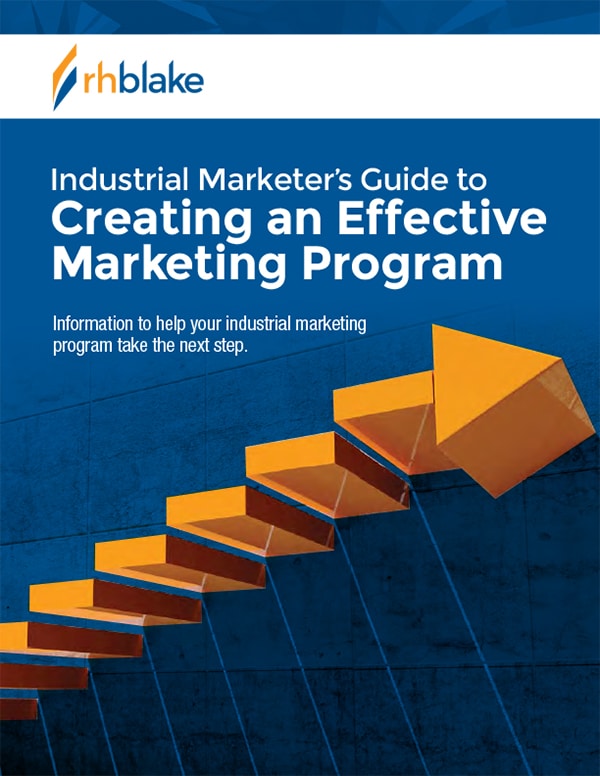
Industrial Marketer’s Guide to Creating an Effective Marketing Program
147 pages of actionable ideas to help you create a winning marketing strategy and program

Industrial Marketer’s Guide to Creating an Effective Marketing Program
147 pages of actionable ideas to help you create a winning marketing strategy and program
Related Clients



